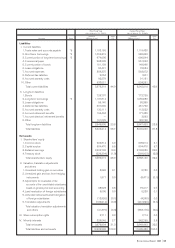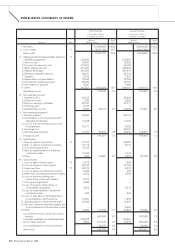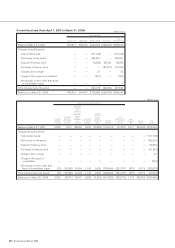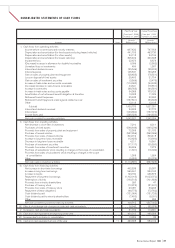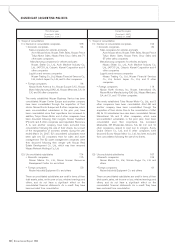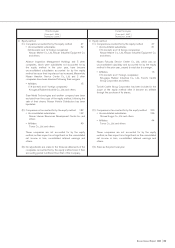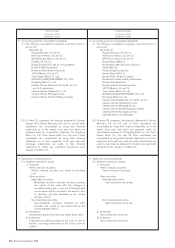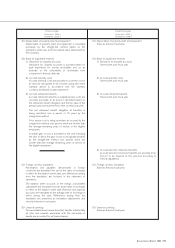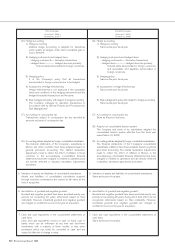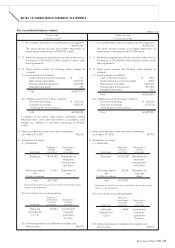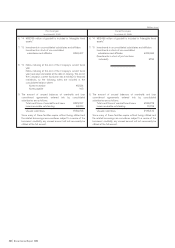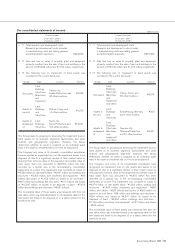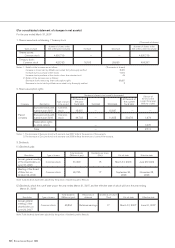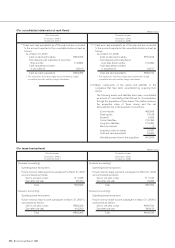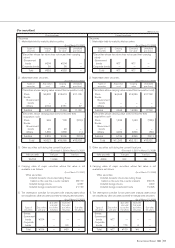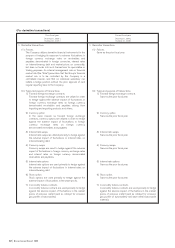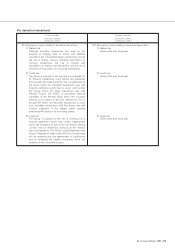Nissan 2008 Annual Report Download - page 55
Download and view the complete annual report
Please find page 55 of the 2008 Nissan annual report below. You can navigate through the pages in the report by either clicking on the pages listed below, or by using the keyword search tool below to find specific information within the annual report.
CHANGES IN ACCOUNTING POLICIES
53
Nissan Annual Report 2008
Prior fiscal year Current fiscal year
From April 1, 2006 From April 1, 2007
[
To March 31, 2007
][
To March 31, 2008
]
Accounting standard for share-based payment
Effective April 1, 2006, the Company adopted the Accounting Standard
for Share-based Payment (ASBJ Statement No. 8 issued on December
27, 2005) and the Implementation Guidance on Accounting Standard for
Share-based Payment (ASBJ Guidance No. 11 issued on May 31, 2006).
The effect of this change was to decrease operating income, ordinary
income, and income before income taxes and minority interests by
¥1,037 million for the year ended March 31, 2007, compared with the
corresponding amounts which would have been recorded if the previous
method had been followed.
The effect of this change on Segment Information is explained in the
applicable notes.
Accounting standard for presentation of net assets in the
balance sheet
Effective April 1, 2006, the Company adopted the Accounting Standard
for Presentation of Net Assets in the Balance Sheet (ASBJ Statement
No. 5 issued on December 9, 2005) and the Implementation Guidance
on Accounting Standard for Presentation of Net Assets in the Balance
Sheet (ASBJ Guidance No. 8 issued on December 9, 2005).
Shareholders’ equity under the previous presentation method
amounted to ¥3,543,420 million as of March 31, 2007.
Net assets in the consolidated balance sheet as of March 31, 2007
have been presented in accordance with the revised “Regulations for
Consolidated Financial Statements.”
Change of Closing Dates of Consolidated Subsidiaries
Until the year ended March 31, 2006, since the difference between the
fiscal year end of the parent company and those of 55 consolidated
subsidiaries was within three months, the operating results of those
subsidiaries were consolidated by using their financial statements as of
their respective fiscal year ends. Effective the year ended March 31,
2007, 22 consolidated subsidiaries have been consolidated by using
their financial statements as of the parent’s fiscal year end prepared
solely for consolidation purposes instead of those as of their respective
fiscal year end. This change was made, upon the completion of the
internal reporting systems which allow those subsidiaries to accelerate
their financial statement closing process, in order to make the disclosures
of the consolidated financial statements more meaningful by unifying the
fiscal year. In addition, 33 consolidated subsidiaries have also changed
their fiscal year end to March 31 for the same reason.
As a result, the financial statements of the 55 consolidated
subsidiaries described above were prepared for the 15-month period
from January 1, 2006 to March 31, 2007. The effect of this change was
to increase consolidated net sales by ¥767,606 million, operating income
by ¥21,443 million, ordinary income by ¥18,483 million, net income
before income taxes and minority interests by ¥15,661 million, and net
income by ¥11,589 million compared with the corresponding amounts which
would have been recorded if the previous method had been followed.
This change was made during the second half of the fiscal year,
because the subsidiaries’ internal systems to accelerate their financial
statements closing processes were completed during that period.
The effect of this change on Segment Information is explained in the
applicable notes.
Accounting for Directors’ Retirement Benefits
Until the year ended March 31, certain subsidiaries expensed retirement
benefits for directors and statutory auditors to income when general
shareholders’ meetings approved resolutions for the payment of those
benefits. In April 2007, a new position paper was issued by the Japanese
Institute of Certified Public Accountants to clarify the accounting
treatment for retirement benefits for directors and statutory auditors. In
this connection, certain subsidiaries began to record an accrual for the
retirement benefits for the directors and statutory auditors at the amount
which would have been required to be paid in accordance with their
respective internal rules if those directors and statutory auditors had
resigned their offices as of the balance sheet date in order to establish a
sound financial position.
The effect of this change was to increase selling, general and
administrative expenses by ¥441 million, to decrease operating income
and ordinary income each by ¥441 million, and to decrease income
before income taxes and minority interests by ¥1,569 million for the year
ended March 31, 2008, compared with the corresponding amounts that
would have been recorded under the previous method.
The effect of this change on Segment Information is explained in the
applicable notes.
“Accrued directors’ retirement benefits” recognized on balance sheets
by some of the Company’s consolidated subsidiaries were previously
included in “Accrued retirement benefits.” Following the aforementioned
change, however, they are separately reported effective from the fiscal
year ended March 31, 2008.


